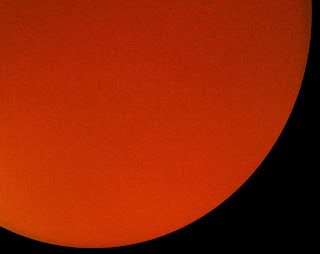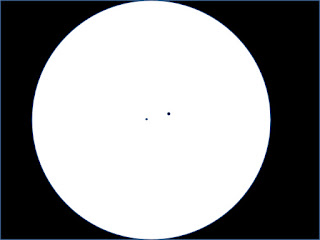February 28th 1600 GMT
It
was well below zero outside, so I checked the Sun in hydrogen alpha light from
inside the house. The Sun was very quiet but I took some shots, just in case I
could capture anything unusual.
February 26th 0840 GMT
I
checked the Sun in my PST and saw a single flare that I had seen on the
professional observatory images. The big question was whether I could capture
it on camera. Using my DSLR for afocal photography was quite new to me. I tried
using a longer focal length eyepiece of 32mm.
Yes, it just shows up a little lower than the centre of the disc and some smaller ones and faint filaments.
February 25th 1810 GMT
I wasn’t happy with my Moon photo in daylight, so decided to
have another go. I used 300mm focal length, ISO 100 and 1/500 second exposure.
I then found Venus low in the west and took some widefield shots at a variety
of exposure times at ISO 6400.
February 25th 1420 GMT
I bin scanned the Moon with my DSLR.
February 25th 1405 GMT
The
Sun was quiet in hydrogen alpha light. I attempted to photograph it using my
DSLR afocally.
February 24th 2320 GMT
I snapped the Moon with my DSLR.
February 24th 1800 GMT
The Sun had set a few minutes before and the Moon was riding
high in the south and I bin scanned it at 8 days past full. The southern
craters were gaining prominence, with Clavius straddling the terminator.
I also bin scanned for Venus low in the west but did not see it.
February 23rd 1700 GMT
The
Moon was half full, so I took another set of shots with my DSLR.
Feb 22nd 1815 GMT
I took a few snaps of the Moon with my DSLR. I processed the best shot.
February 12th 1020 GMT
I bin scanned the Sun through moving thin cloud and saw that
the sunspots from the day before had rotated. The Big Bear images showed some
smaller sunspots in the same region that I did not pick up in my bins.
February 11th 0910 GMT
I bin scanned the Sun in a clear sky and saw two sunspots.
February 9th 0820 GMT
I tried to photograph the Sun from indoors, still not being
100% fit. It was too low and shining through trees but I thought it would make
an interesting shot anyway.
A few minutes later, it had cleared the trees, so I carried
out the planned shot. It didn't work, probably as it was indoors, so I did a drawing from visual observations.
February 9th 0750 GMT
The Moon was a waning crescent and I took some shots with my
DSLR at 300mm focal length, ISO 100 and 1/1000 second exposure.
February 6th 1305 GMT
I bin scanned the Sun in a clear sky and saw a single, large sunspot.
February 4th 1040 GMT
I finally had some clear sky, so checked out the Sun from
indoors with my PST, as I was still ill. I could see some granulation and tried
to photograph afocally using my DSLR at 70mm and auto-exposure, with a lens
hood. Initial indication were that I’d captured some parts of the solar disc. One shot caught part of the disc quite well but I could not extract any detail from the others. At least, there was something in the concept.
February 1st 0640 GMT
The
Moon was low and bright in the west. I still had a cold, so I photographed it
from the house with my DSLR.
Unfortunately, focussing a DSLR at 300mm on the Moon is a bit hit and miss and this time it was a miss.



















